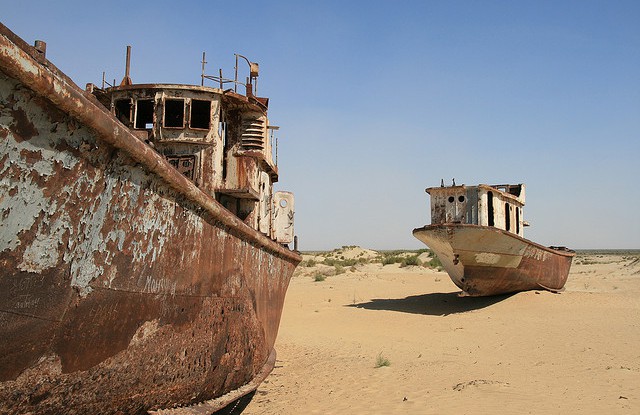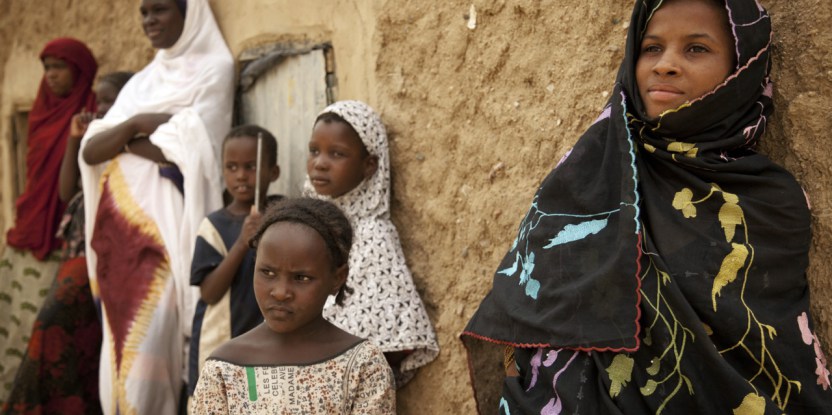BOGOR, Indonesia — An approach that looks at both environmental and human elements to combat landscape degradation could help make dryland agriculture in Central Asia more resilient to climate change, according to a recent report.
The Aral Sea between Kazakhstan and Uzbekistan was once one of the largest lakes in the world, but since the 1960s, major agricultural irrigation developments have tapped the rivers that supplied it with water, leading to the lake’s almost complete depletion today.
Irrigated croplands in the Aral Sea basin are highly vulnerable to climate change, as they rely on meltwater from glacier and snow reserves in mountains to the east. Climate change there exacerbates an already precarious combination: an extremely arid climate; a large volume of water used for irrigating agriculture; low water-use efficiency; and poor quality for irrigation due to salinity. Added up, this is troubling news for future food security in the region.
What to do?
A more integrated management framework is required to look at the relationships among climate pressure, environmental degradation and water-use inefficiency, according to the review, which focuses on the Khorezm region in the irrigated lowlands of northwest Uzbekistan.
Creating a strategy that jointly addresses the social and ecological aspects of the system could help in developing more successful adaptation and mitigation strategies throughout Central Asia, the report asserts.
The activities needed to reduce risk go beyond simply better land- and water-use technologies, one researcher says.
CHANGE OF HABITS
“Rebuilding environmental and human resilience in the region requires not only improving water-use efficiency—which is what everybody surmises—but a systematic change to crop-planting patterns that reduce the exposure of rural communities to climate change risks, such as the use of a broader mix of crops and the use of perennial instead of annual crops on degraded croplands that are not competing with food production,” said Christopher Martius, principal scientist with the Center for International Forestry Research (CIFOR), co-author of the review of vulnerability and policy options in the region.
Awareness raising and shifting government policies ... would go a long way to mitigating the risks from climate change in dry areas
“Changing land use habits can also help,” he said. “For example, afforestation — the planting of trees on degraded croplands — and the introduction of resource-smart cultivation practices such as ‘conservation agriculture’—built on reduced on-field traffic, better soil management and adequate crop rotations—can really help adapt to the effects of climate change and variability.
“Conservation agriculture has been shown to be often more economically viable than the current cropping systems, and it helps restoring ecological soil functions.”
Farmers also need better knowledge about the environmental and economic benefits from planting trees, and governments need to support this through the right policies, Martius added.
Uzbekistan might benefit from considering a move away from current crop policies, which are based on high levels of subsidies and a differential crop quota system that prioritizes cotton for export and wheat for food security, toward giving more importance to other crops, including less water-intensive ones, the report says.
LESSONS FOR DRYLANDS
Incentives should aid rural populations to practice sustainable resource management, incorporating social equity and environmental preservation, it said. Also current uncertainty about land ownership related to reforms does little to incentivize farmers to invest in adaptation.
Additionally, improved conditions for the marketing of agricultural products, better storage and cooling facilities, and a stronger value generation in the country through upgraded processing and refinement sectors, instead of exporting cotton fiber, could help adapting agricultural production and trade to a more variable future.
Finding solutions to the environmental troubles in the region could have far-reaching implications beyond Central Asia. More than 2 billion people live in drylands worldwide, and the economic impact of ongoing land degradation globally is equal to $40 billion a year, according to statistics from the U.N. Food and Agriculture Organization.
Droughts and land degradation are associated with worldwide climate change, which is expected to hit Central Asia harder than some other regions.
“Awareness raising and shifting government policies to more equitable and participatory distribution of decision-making among agricultural and water management stakeholders would go a long way to mitigating the risks from climate change in dry areas,” Martius said.
For further information on the topics discussed in this story, please contact Christopher Martius at c.martius@cgiar.org.
CIFOR’s research on climate change forms part of the CGIAR Research Program on Forests, Trees and Agroforestry.
We want you to share Forests News content, which is licensed under Creative Commons Attribution-NonCommercial-ShareAlike 4.0 International (CC BY-NC-SA 4.0). This means you are free to redistribute our material for non-commercial purposes. All we ask is that you give Forests News appropriate credit and link to the original Forests News content, indicate if changes were made, and distribute your contributions under the same Creative Commons license. You must notify Forests News if you repost, reprint or reuse our materials by contacting forestsnews@cifor-icraf.org.

